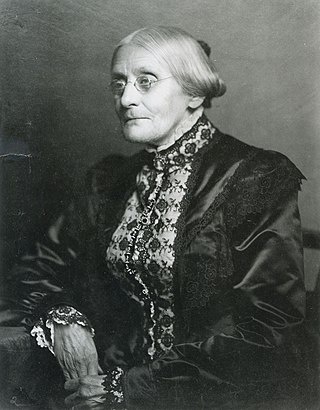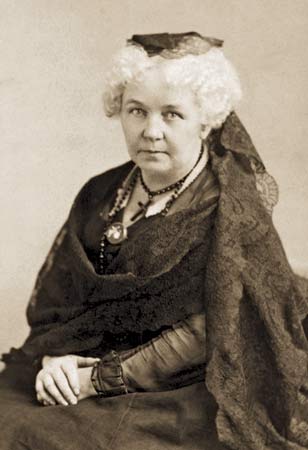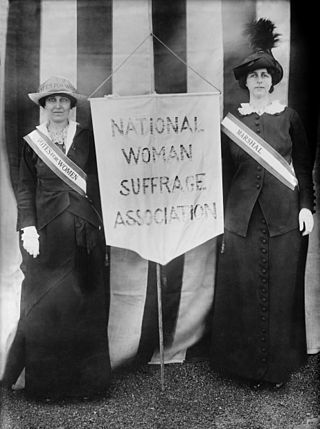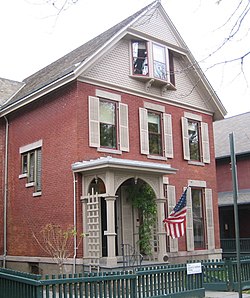
Susan B. Anthony was an American social reformer and women's rights activist who played a pivotal role in the women's suffrage movement. Born into a Quaker family committed to social equality, she collected anti-slavery petitions at the age of 17. In 1856, she became the New York state agent for the American Anti-Slavery Society.

Elizabeth Cady Stanton was an American writer and activist who was a leader of the women's rights movement in the U.S. during the mid- to late-19th century. She was the main force behind the 1848 Seneca Falls Convention, the first convention to be called for the sole purpose of discussing women's rights, and was the primary author of its Declaration of Sentiments. Her demand for women's right to vote generated a controversy at the convention but quickly became a central tenet of the women's movement. She was also active in other social reform activities, especially abolitionism.

Rochester is a city in the U.S. state of New York, the seat of Monroe County, Rochester is the fourth most populated Municipality in New York with a population of 211,328 at the 2020 United States census. Located in Western New York, the city of Rochester forms the core of a larger metropolitan area with a population of 1 million people, across six counties. The city was one of the United States' first boomtowns, initially due to the fertile Genesee River Valley, which gave rise to numerous flour mills, and then as a manufacturing center, which spurred further rapid population growth.

The National Woman Suffrage Association (NWSA) was formed on May 15, 1869, to work for women's suffrage in the United States. Its main leaders were Susan B. Anthony and Elizabeth Cady Stanton. It was created after the women's rights movement split over the proposed Fifteenth Amendment to the U. S. Constitution, which would in effect extend voting rights to black men. One wing of the movement supported the amendment while the other, the wing that formed the NWSA, opposed it, insisting that voting rights be extended to all women and all African Americans at the same time.

The National American Woman Suffrage Association (NAWSA) was an organization formed on February 18, 1890, to advocate in favor of women's suffrage in the United States. It was created by the merger of two existing organizations, the National Woman Suffrage Association (NWSA) and the American Woman Suffrage Association (AWSA). Its membership, which was about seven thousand at the time it was formed, eventually increased to two million, making it the largest voluntary organization in the nation. It played a pivotal role in the passing of the Nineteenth Amendment to the United States Constitution, which in 1920 guaranteed women's right to vote.

This article documents the history of Rochester, New York, in western New York State. Settlement began in the late 18th century, and the city flourished with the opening of the Erie Canal. It became a major manufacturing center, and attracted many Italians, Germans, Irish and other immigrants, as well as a dominant group of Yankees of New England origin. The Yankees made Rochester the center of multiple reform movements, such as abolitionism and women's rights. It was famous as the center of the American photography industry, with headquarters of Eastman Kodak. In the 1970s it became fashionable to call the industrial cities along the Great Lakes 'rustbelt cities' following the move away from steel, chemical and other hard goods manufacturing. Rochester, with the presence of Ritter-Pfaulder, Bausch and Lomb, Eastman Kodak, Xerox, Gannett and other major industries, defied the trend for many decades following WWII.

The First Unitarian Church of Rochester is located at 220 Winton Road South in Rochester, New York, U.S. The congregation is one of the largest in its denomination, the Unitarian Universalist Association. The non-creedal church conducts programs in the areas of spirituality, social concerns, music, and arts. This church is one of two Unitarian Universalist congregations in Monroe County, the other being First Universalist Church of Rochester.

Women's legal right to vote was established in the United States over the course of more than half a century, first in various states and localities, sometimes on a limited basis, and then nationally in 1920 with the passing of the 19th Amendment.

Mary Barr Clay was a leader of the American women's suffrage movement. She also was known as Mary B. Clay and Mrs. J. Frank Herrick.

The Campbell–Whittlesey House, also known as the Benjamin Campbell House, in Rochester, New York is an historic Greek Revival home, designed by architect Minard Lafever. It was built in 1836, and added to the National Register of Historic Places on February 18, 1971.

Hervey Ely House, also known as the Daughters of the American Revolution Chapter House, is a historic home located at Rochester in Monroe County, New York.
Madison Square–West Main Street Historic District is a national historic district located in the Susan B. Anthony Neighborhood of Rochester in Monroe County, New York. The district consists of 102 contributing structures and two contributing sites. Sixty five of the contributing structures are residential, with three contributing dependencies. Also in the district are 24 contributing commercial buildings and nine industrial buildings. The two sites are Susan B. Anthony Square and a former carriage company storage yard. Located within the district boundaries is the separately listed Susan B. Anthony House.
This timeline highlights milestones in women's suffrage in the United States, particularly the right of women to vote in elections at federal and state levels.

Women's suffrage was established in the United States on a full or partial basis by various towns, counties, states and territories during the latter decades of the 19th century and early part of the 20th century. As women received the right to vote in some places, they began running for public office and gaining positions as school board members, county clerks, state legislators, judges, and, in the case of Jeannette Rankin, as a member of Congress.

United States v. Susan B. Anthony was the criminal trial of Susan B. Anthony in a U.S. federal court in 1873. The defendant was a leader of the women's suffrage movement who was arrested for voting in Rochester, New York in the 1872 elections in violation of state laws that allowed only men to vote. Anthony argued that she had the right to vote because of the recently adopted Fourteenth Amendment to the U.S. Constitution, part of which reads, "No State shall make or enforce any law which shall abridge the privileges or immunities of citizens of the United States."
The West Virginia Equal Suffrage Association (WVESA) was an organization formed on November 29, 1895, at a conference in Grafton, West Virginia. This conference and the subsequent annual conventions were an integral part of the National American Woman Suffrage Association's Southern Committee's work to reach into previously under-represented areas for supporting the women's suffrage movement. The WVESA relied not only on the national association but also worked together with activists from the state's chapter of the Woman's Christian Temperance Union, state chapter of the General Federation of Women's Clubs, and the clubs affiliated with the National Association of Colored Women's Clubs to win the right to vote. Though they lost in a landslide the 1916 referendum to amend the state's constitution for women's suffrage, the group provided the strong push for ratifying the federal amendment in spring 1920 that led to West Virginia becoming the thirty-fourth of the thirty-six states needed. That fall, West Virginia women voted for the first time ever, and the WVESA transformed itself into the League of Women Voters of West Virginia.

The Women's Rights Pioneers Monument is a sculpture by Meredith Bergmann. It was installed in Central Park, Manhattan, New York City, on August 26, 2020. The sculpture is located at the northwest corner of Literary Walk along The Mall, the widest pedestrian path in Central Park. The sculpture commemorates and depicts Sojourner Truth, Susan B. Anthony (1820–1906), and Elizabeth Cady Stanton (1815–1902), pioneers in the suffrage movement who advocated women’s right to vote and who were pioneers of the larger movement for women’s rights.

Women's suffrage in Colorado had an early victory, being the second state to grant women's suffrage and the first to do so through a voter referendum in 1893. Even while Colorado was a territory, lawmakers and other leaders tried to include women's suffrage in laws and later in the state constitution. The constitution did give women the right to vote in school board elections. The first voter referendum campaign was held in 1877. The Woman Suffrage Association of Colorado worked to encourage people to vote yes. Nationally-known suffragists, such as Susan B. Anthony and Lucy Stone spoke alongside Colorado's own Alida Avery around the state. Despite the efforts to influence voters, the referendum failed. Suffragists continued to grow support for women's right to vote. They exercised their right to vote in school board elections and ran for office. In 1893, another campaign for women's suffrage took place. Both Black and white suffragists worked to influence voters, gave speeches, and turned out on election day in a last-minute push. The effort was successful and women earned equal suffrage. In 1894, Colorado again made history by electing three women to the Colorado house of representatives. After gaining the right to vote, Colorado women continued to fight for suffrage in other states. Some women became members of the Congressional Union (CU) and pushed for a federal suffrage amendment. Colorado women also used their right to vote to pass reforms in the state and to support women candidates.
Corinthian Hall was a meeting hall in Rochester, New York, that was the site of significant speeches and other events. It was built in 1849 and was destroyed by a fire in 1898.
























